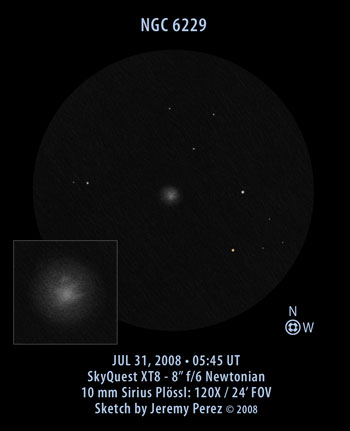Observation Notes:
I could not resolve stars or even a vague sense of graininess in this globular. It did have a lumpy, mottled appearance. Averted vision showed an extended halo about 2 arc minutes in diameter. The brighter core region was somewhat rectangular with extensions running toward the northwest. A dull orange star marked the southwest side of the view.
Object Information:
NGC 6207 was discovered by Friedrich Wilhelm Herschel in 1787. Based on his visual impression, he described it as a planetary nebula. It wasn’t until the middle of the next century that d’Arrest revealed it to be a “very crowded cluster”. Difficulty in resolving it can be attributed to its large distance from Earth of nearly 100,000 light years. It is also cataloged as: H IV-50, GC 4244, GCL 47
| Subject | NGC 6229 |
| Classification* | Globular Cluster (4) |
| Position* | Hercules [RA: 16:46:58.8 / Dec: +47:31:40] |
| Size* | 4.5′ |
| Brightness* | 9.4 vMag |
| Date/Time | July 30, 2008 – 10:45 PM MST (July 31, 2008 – 5:45 UT) |
| Observing Loc. | Flagstaff, Arizona, USA – Home |
| Instrument | Orion SkyQuest XT8 (203 mm dia./1200 mm F/L) |
| Eyepieces/Mag. | 10 mm Sirius Plössl (120X) also with 2X Barlow (240X) |
| Conditions | Clear, calm |
| Seeing | 6/10 Pickering |
| Transparency | ~ Mag 6.0 NELM |
| *References | NGCIC.org; SEDS |

Dus hier zitten jullie verstopt.When do you come along?
I also observed this cluster through my 8″ reflector to test my scope’s visual limit from my city. I saw a fuzzy spot forming triangle with two stars. This is an easy globular.
Thanks for sharing your observation. This was definitely a nice GC.